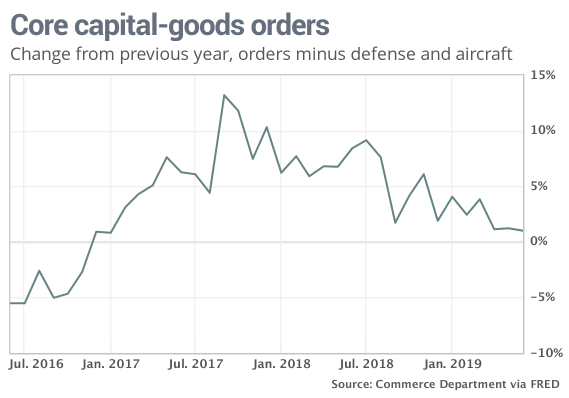U.S. China tensions over trade policy have reached a boiling point, the only question remaining is whether business executives — and the stock market — can stand the heat.
On what was supposed to be a day focused on Federal Reserve policy, international trade stole the spotlight Friday as investors focused on China’s announcement new retaliatory tariffs, which President Trump responded to with unusually strong rhetoric, saying U.S. companies were “hereby ordered to immediately start looking for alternatives to China.”
The further upping of trade barriers, along with Trump’s forceful response, threatens to further erode already sagging business confidence and trigger more weakness in U.S. business investment, which could eventually lead to rising unemployment, market observers say.
”The latest Trump tweets, directing businesses to get out of China, though it’s not something he can actually do, won’t be received well by the Chinese,” Bart Oosterveld, director of global business and economics at the Atlantic Council, told MarketWatch. “It’s something that corporate boards and executives are going to be talking about. If I were an American company thinking of where to expand, I’d probably press the pause button.”
After U.S. stocks traded mostly sideways Friday morning, the president’s statements triggered a sharp decline in the major indexes, with the Dow Jones Industrial Average DJIA, -2.37% closing down 623.34 points or 2.37% at 25,628.90, the S&P 500 SPX, -2.59% down 75.84 points or 2.59% at 2,847.11, and the Nasdaq Composite index COMP, -3.00% ending the day down 239.62 points or 3.00% at 7751.77.
“The announcement from China, because we don’t export that much to China, was more symbolic than material,” Mike Loewengart, chief market strategist at E-Trade told MarketWatch. “But additional retaliatory measures from the U.S. and the likelihood that this will prolong the trade war and perhaps take it to new depths,” was alarming to investors, he said.
Looking forward, Monday will see the release of two closely watched measure of business investment, U.S. durable goods orders and core capital expenditures, and this data could be a catalyst for further market volatility if they indicated additional retrenchment in capital investment.
“When it comes to business investment metrics, any indication that businesses are facing too much pressure could be viewed negatively by markets,’ said Lowengart.
Last month’s core capex data did not inspire much confidence, as it showed a further slowdown in capital investment growth that has been ongoing all year.

What’s more, a recent report on second-quarter U.S. GDP growth showed gross private domestic investment falling 5.5%, though overall economic growth remained a solid 2.1% on the strength of consumer and government spending. Investors will get a revision of the second-quarter GDP print on Thursday this week, and will be watching to see if these indicators worsen or improve.
Analysts are also growing more concerned that heightened trade war rhetoric will dampen consumer confidence and spending, damaging the engine that has been powering economic growth of late. “You have to wonder at what point does consumer sentiment catch up to what you’re seeing at the management level,” Jody Lurie, corporate credit analyst at Janney Montgomery Scott in an interview.
Another worrying scenario is that business retrenchment will lead to slower growth, triggering more cost cutting that eventually spills over into the labor market. “If there’s going to be an economic slowdown, it’s going to start in the business sector, like it almost always does, wrote Tom Essaye, president of the Sevens report in a Friday note to clients.
Reductions in global demand and heightened uncertainty could cause businesses to “hunker down,” and focus on cost cutting to boost earnings, rather than spending to grow revenue. This could create a self-reinforcing cycle of lower business spending and lower economic growth that eventually causes employers to consider cutting worker hours or initiating layoffs, he wrote.
While such a scenario remains speculative amid data showing a thriving consumer, investors will be sensitive to any evidence that such a pattern is forming.
Key data on the U.S. consumer will also be on tap this week, with the Case-Shiller home price index to be released Tuesday, along with the Conference Board’s consumer confidence index. Thursday will see data on new applications for unemployment benefits, pending home sales, and the trade deficit.
On Friday, the Fed’s preferred measure of inflation, the personal consumption expenditures index, will be released, which will also provide insight into consumer spending and income growth.
Second-quarter earnings season is winding down, but a few key companies will issue results this week including Autodesk Inc. ADSK, -0.84% and Hewlett Packard Enterprise Co. HPE, -3.77% on Tuesday, Brown-Forman Corp. BF.A, -1.11% BF.B, -1.56% and Tiffany & Co. TIF, -4.71% on Wednesday and Workday Inc. , Dollar General Corp. DG, -1.97%, Dollar Tree Inc. DLTR, -2.11%, Ulta Beauty Inc. and Best Buy Co. Inc. BBY, -3.76% on Thursday.










Add Comment